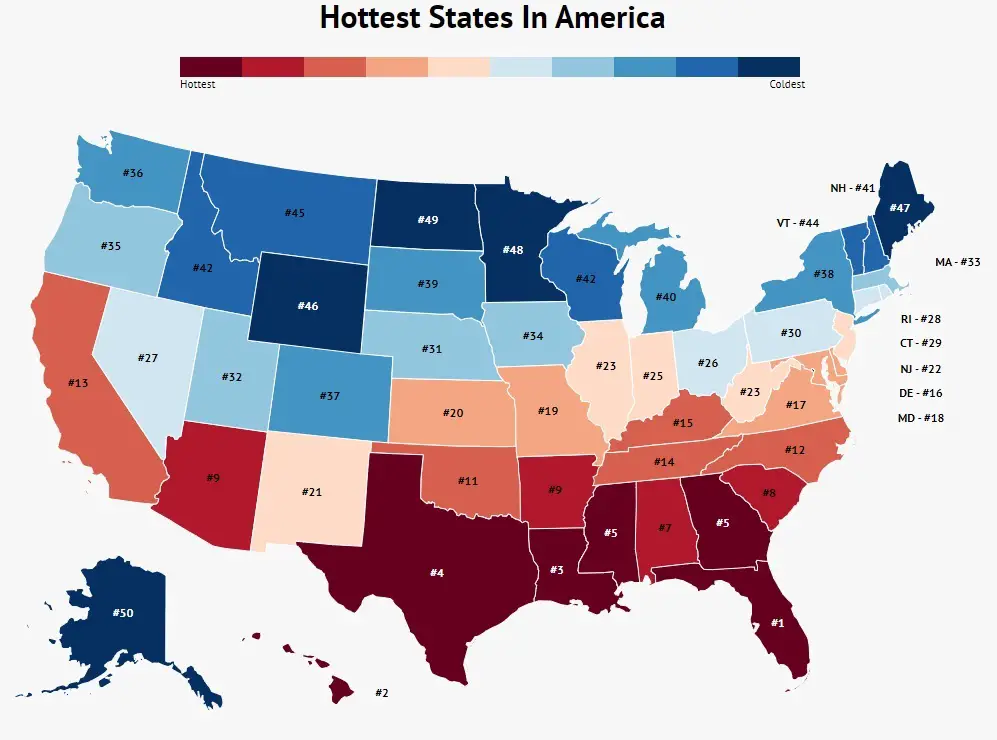When it comes to the hottest state in the United States, many people immediately think of Arizona or Texas, and for good reason. These states are known for their scorching temperatures, especially during the summer months. However, determining the absolute hottest state involves considering several factors, including geographic location, climate patterns, and historical weather data. Understanding which state holds this title provides valuable insights into how extreme heat impacts daily life, ecosystems, and infrastructure.
The United States is a vast country with diverse climates ranging from freezing cold in Alaska to sweltering heat in the southern and southwestern regions. Among these, one state stands out as the hottest due to its desert landscapes, high temperatures, and arid conditions. This article delves into the factors that make this state the hottest and examines how residents and visitors adapt to such extreme weather.
Throughout this article, we will explore the hottest state in the United States by analyzing climatic data, geographic influences, and real-world impacts. By the end, you'll have a comprehensive understanding of why this state earns its reputation as the hottest and what it means for those who live there.
Read also:Taylor Swifts Education A Comprehensive Look At Her Academic Journey
Table of Contents
- Geography of the Hottest State
- Climate Patterns in the Hottest State
- Temperature Records in the United States
- Why Arizona is Considered the Hottest State
- Comparing Arizona to Other Hot States
- Effects of Extreme Heat on Daily Life
- Health Implications of High Temperatures
- How Residents Adapt to Extreme Heat
- Tourism in the Hottest State
- Future Trends in Climate and Heat
Geography of the Hottest State
The geography of a region plays a crucial role in determining its climate. Arizona, widely regarded as the hottest state in the United States, is located in the southwestern part of the country. Its landscape is dominated by deserts, mountains, and plateaus, with the Sonoran Desert being one of the most prominent features. This desert environment contributes significantly to the state's high temperatures.
Key Geographic Features
- **Sonoran Desert**: Known for its intense heat and unique flora such as the saguaro cactus.
- **Mojave Desert**: Another desert region that spans parts of Arizona, adding to its arid conditions.
- **Grand Canyon**: While not directly related to heat, this iconic landmark showcases the state's diverse topography.
Arizona's elevation also influences its temperature. Lower elevations, particularly in cities like Phoenix and Tucson, experience higher temperatures compared to areas at higher altitudes.
Climate Patterns in the Hottest State
The climate of Arizona is classified as arid and semi-arid, characterized by minimal rainfall and prolonged periods of sunshine. This climate pattern creates the perfect conditions for extreme heat. The state experiences long, hot summers with temperatures often exceeding 100°F (38°C).
Seasonal Variations
Summer is the hottest season in Arizona, with temperatures peaking in June and July. Winter, on the other hand, is relatively mild, especially in the southern parts of the state. However, even in winter, daytime temperatures can be warm, making Arizona a popular destination for those seeking sun and warmth year-round.
Monsoon season, which typically occurs from July to September, brings some relief through sporadic rainfall. However, the humidity during this period can make the heat feel more oppressive.
Temperature Records in the United States
To understand why Arizona is considered the hottest state, it's essential to look at temperature records. According to the National Oceanic and Atmospheric Administration (NOAA), Arizona has recorded some of the highest temperatures in the United States. The official highest temperature ever recorded in Arizona was 128°F (53°C) in Lake Havasu City on June 29, 1994.
Read also:Joey Drea De Matteo A Rising Star In The Entertainment Industry
Notable Temperature Records
- **Phoenix**: Known for its consistently high temperatures, Phoenix often tops lists of the hottest cities in the U.S.
- **Yuma**: This city holds the record for the most days with temperatures above 100°F.
- **Death Valley**: While technically located in California, Death Valley, which is part of the Mojave Desert that extends into Arizona, holds the record for the highest temperature ever recorded on Earth at 134°F (56.7°C).
These records highlight the extreme heat conditions that Arizona and its neighboring regions experience.
Why Arizona is Considered the Hottest State
Arizona's claim to being the hottest state in the United States is supported by several factors:
- **Geographic Location**: Situated in the southwestern desert region, Arizona is naturally predisposed to high temperatures.
- **Desert Climate**: The arid climate and lack of significant rainfall contribute to the state's extreme heat.
- **Urban Heat Island Effect**: Cities like Phoenix and Tucson experience amplified heat due to urbanization and the concentration of buildings and infrastructure.
While other states, such as Texas and Florida, also experience hot weather, Arizona's combination of desert geography and climate sets it apart as the hottest.
Comparing Arizona to Other Hot States
Arizona vs. Texas
Both Arizona and Texas are known for their hot climates, but Arizona generally experiences higher temperatures. Texas has a more diverse climate, with some areas receiving more rainfall and having cooler temperatures compared to Arizona's consistently arid conditions.
Arizona vs. Florida
Florida's heat is characterized by high humidity, which can make the heat feel more oppressive. However, Arizona's dry heat often results in higher actual temperatures, making it the hotter state overall.
This comparison underscores the unique factors that contribute to Arizona's status as the hottest state.
Effects of Extreme Heat on Daily Life
Living in the hottest state presents unique challenges for residents and visitors alike. Extreme heat affects various aspects of daily life, from transportation to outdoor activities.
Impact on Transportation
High temperatures can cause road surfaces to expand and crack, leading to increased maintenance needs. Additionally, extreme heat can affect vehicle performance, particularly in older cars, leading to more frequent breakdowns.
Outdoor Activities
Residents and tourists must take precautions when engaging in outdoor activities during the summer months. Staying hydrated, wearing protective clothing, and scheduling activities during cooler parts of the day are essential for safety.
Health Implications of High Temperatures
Extreme heat poses significant health risks, including heat exhaustion and heatstroke. Vulnerable populations, such as the elderly and young children, are particularly at risk. Public health initiatives in Arizona focus on educating the public about the dangers of extreme heat and providing resources for staying cool and safe.
Preventive Measures
- Stay hydrated by drinking plenty of water.
- Limit outdoor activities during peak heat hours.
- Use air conditioning or cooling centers to escape the heat.
These measures help mitigate the health risks associated with living in the hottest state.
How Residents Adapt to Extreme Heat
Arizona residents have developed various strategies to cope with the extreme heat. From architectural design to community initiatives, adaptation is a key aspect of life in the state.
Architectural Design
Homes and buildings in Arizona are often designed with heat mitigation in mind. Features such as shaded patios, reflective roofing materials, and energy-efficient windows help keep interiors cool.
Community Initiatives
Local governments and organizations offer resources such as cooling centers and public awareness campaigns to help residents manage the heat effectively.
Tourism in the Hottest State
Despite the extreme heat, Arizona remains a popular tourist destination. Attractions such as the Grand Canyon, Sedona's red rocks, and the vibrant city life of Phoenix draw millions of visitors each year. Tourists are encouraged to plan their visits during cooler months or take advantage of indoor attractions during the summer.
Popular Attractions
- **Grand Canyon National Park**: A natural wonder that attracts millions annually.
- **Sedona**: Known for its stunning landscapes and spiritual significance.
- **Phoenix**: Offers a mix of cultural experiences, shopping, and dining options.
These attractions highlight the diversity and appeal of Arizona despite its hot climate.
Future Trends in Climate and Heat
As global climate patterns continue to evolve, the future of extreme heat in Arizona remains a topic of concern. Scientists predict that temperatures will continue to rise, leading to longer and more intense heatwaves. This trend underscores the importance of continued adaptation and mitigation efforts.
Climate Change Impacts
Climate change is expected to exacerbate the already extreme heat conditions in Arizona. Increased temperatures could lead to more frequent and severe heatwaves, impacting ecosystems, agriculture, and human health.
Efforts to address these challenges include promoting sustainable practices, enhancing infrastructure resilience, and supporting research into climate adaptation strategies.
Conclusion
In conclusion, Arizona stands out as the hottest state in the United States due to its desert geography, arid climate, and consistently high temperatures. Understanding the factors that contribute to this status provides valuable insights into how extreme heat impacts daily life, ecosystems, and infrastructure. By taking proactive measures to adapt to and mitigate the effects of extreme heat, residents and visitors can continue to thrive in this remarkable state.
We encourage you to share your thoughts and experiences with extreme heat in Arizona by leaving a comment below. Additionally, explore other articles on our site to learn more about climate, geography, and the fascinating world around us.


